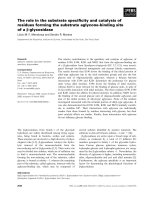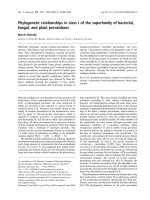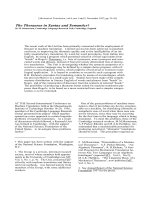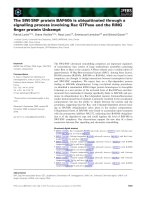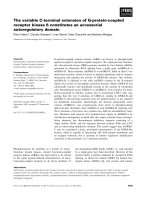Báo cáo khoa học: "The article in possible status of wood quality oak breeding programs (Quercus petraea Liebl and Quercus robur L)" pps
Bạn đang xem bản rút gọn của tài liệu. Xem và tải ngay bản đầy đủ của tài liệu tại đây (363.89 KB, 7 trang )
Original
article
The
possible
status
of
wood
quality
in
oak
breeding
programs
(Quercus petraea
Liebl
and
Quercus
robur
L)
G Nepveu
INRA,
Station
de
Recherches
sur
la
Qualité
des
Bois,
Champenoux
54280
Seichamps,
France
Summary —
The
first
part
of
the
paper
presents
experimental
results
illustrating
the
very
high
level
of
phenotypic
variability
of
the
anatomical
and
physical
characteristics
of
the
wood
(Quercus petraea
and
Quercus
robur)
(density,
shrinkage,
color,
etc)
and
technological
properties,
namely
suitability
for
slicing.
Then
some
studies
are
reviewed,
which
show
that
a
large
part
of
the
phenotypic
variabil-
ity
in
the
wood
of
oak
is
likely
to
be
under
genetic
control
(individual
level).
In
the
second
part
of
the
paper,
3
kinds
of
studies
which
are
still
needed
for
optimum
selection
of
wood
quality
are
proposed:
1)
defining
realistic
selection
criteria
for
wood
quality;
2)
confirming
genetic
control
of
wood
quality
criteria;
and
3)
defining
conditions
for
performing
optimum
selection
for
wood
quality.
This
last
point
is
treated
in
the
context
of
possible
developments
in
oak
silviculture
and
regeneration.
Quercus
/
wood
/
quality
/
breeding
/
selection
Résumé —
Place
possible
de
la
qualité
du
bois
dans
les
programmes
d’amélioration
généti-
que
des
chênes
(Quercus
petraea
Liebl
et
Quercus
robur
L).
Dans
une
première
partie,
l’auteur
présente
des
résultats
expérimentaux
témoignant
d’une
variabilité
phénotypique
très
forte
pour
les
caractéristiques
anatomiques,
physiques
(densité,
retrait,
couleur
du
bois,
etc)
et
technologiques,
notamment
l’aptitude
au
tranchage,
des
bois
de
chênes
rouvre
et
pédonculé.
Il
poursuit
en
faisant
état
des
résultats
de
quelques
études
qui
montrent
qu’une
partie
importante
de
la
variabilité
phéno-
typique
serait
sous
contrôle
génétique
(variabilité
génétique
intraprovenance).
Dans
une
seconde
partie,
les
études
préalables
à
la
prise
en
compte
de
la
qualité
en
matière
de
sélection
des
chênes
sont
évoquées :
1)
définition
de
critères
réalistes
de
sélection
pour
la
qualité;
2)
confirmation
de
la
réalité
du
contrôle
génétique
sur
les
critères
de
qualité
et 3)
définition
des
conditions
de
réalisation
de
la
sélection.
Ce
dernier
point
est
traité
en
tenant
compte
des
évolutions
possibles
de
la
sylvicul-
ture
appliquée
aux
chênes.
Quercus
/
bois
/
qualité
/ amélioration
génétique
/ sélection
INTRODUCTION
The
aim
of
this
paper
is
to
examine
the
im-
portance
of
wood
quality
in
an
oak
breed-
ing
program.
Two
questions
arise:
why
take
wood
quality
into
account?
How
can
it
be
taken
into
account?
Only
Quercus
petraea
Liebl
and
Quercus
robur
L
are
considered
here.
In
France,
these
are
the
only
oaks
of
economic
interest.
First
of
all,
it
seems
to
be
useful
to
define
realistic
criteria
for
the
wood
quality
of
oak.
Furniture
and
joinery
are
uses
of
primary
interest
for
oak.
The
decreasing
availability
of
high-grade
tropical
timbers
will
empha-
size
the
economic
significance
of
oak
for
such
uses.
For
these
purposes,
the
follow-
ing
characteristics
are
necessary
(Nepveu,
1990),
in
addition
to
suitably
shaped
logs:
1)
low
wood
shrinkage;
2)
no
internal
cracks,
namely
frost
shakes;
3)
straight
grain; 4)
suitable
color
and
other
esthetic
traits
(especially
regularity
of
radial
growth);
and
5)
small
amount
of
sapwood.
WHY
TAKE
WOOD
QUALITY
INTO
ACCOUNT
IN
AN
OAK
BREEDING
PROGRAM?
High
level
of
phenotypic
variability
for
basic
and
technological
properties
in
wood
of
oak
All
studies
devoted
to
oak
have
shown
that
the
phenotypic
variability
of
the
wood
prop-
erties
of
Q
petraea
and
Q
robur
is
very
high.
Table
I gives
some
examples
of
such
variability
observed
on
some
wood
ana-
tomical
characteristics,
basic
and
techno-
logical
properties.
In
oak,
high
levels
of
phenotypic
vari-
ability
have
also
been
detected
for
spiral
grain
(Birot
et
al,
1980)
and
sensitivity
to
frost
cracks
(Miller,
1987).
If
the
priority
of
wood
quality
for
some
forest
species
is
sometimes
discussed,
these
data
clearly
show
that
in
oak,
wood
properties
cannot
be
neglected
because
they
are
too
important
for
the
use
in
joinery
and
furniture
making.
In
addition,
only
part
of
the
large
pheno-
typic
variability
of
oak
wood
properties
is
explained
by
ring
width.
This
means
that
trees
of
good
quality
and
relatively
high
rates
of
radial
growth
can
be
found.
In
many
cases,
between-tree
variabilities
are
given
for
mixed
Q
robur
and
Q
petraea
trees.
However,
it
should
be
noted
that
the
amount
of
phenotypic
variability
remains
very
high
in
each
species.
Presumption
and
first
experimental
results
about
genetic
control
of
wood
quality
in
oak
Presumption
about
genetic
control
Presumptions
about
the
genetic
control
of
wood
quality
are
based
on
3
facts:
1)
in
other
tree
species,
the
genetic
control
of
most
wood
properties
is
high
at
the
indi-
vidual
tree
level
(Nepveu,
1986);
2)
in
oak,
between-tree
variability
for
wood
properties
appears
to
be
high
even
if
these
trees
are
even-aged,
have
the
same
ring
widths,
have
grown
in
the
same
stand.
So,
between-tree
variability
cannot
be
explained
by
silviculture
and
environ-
ment
but
only
by
microsite
and/or
genetic
differences;
and
3)
in
oak,
even
if
be-
tween-tree
variability
is
high,
many
wood
properties
do
not
vary
significantly
within
the
tree
(when
ring
width
and
age
from
the
pith
are
fixed).
As
mentioned
above,
this
fact
has
to
be
related
to
microsite
and
genetic
effects.
However,
taking
into
ac-
count
the
rotation
length
in
oak
silvicul-
ture,
it
is
doubtful
that
microsite
differenc-
es
could
explain
the
observation
that
the
cambium
of
a
200-year-old
tree
has
pro-
duced
earlywood
vessels
of
the
same
di-
ameter
during
most
of
its
life!
First
experimental
results
about
genetic
control
Because
of
the
small
number
of
experi-
mental
plots
available,
there
is
little
infor-
mation
about
the
genetic
control
of
wood
properties
in
oak.
In
spite
of
this,
results
obtained
by
Nepveu
(1982,
1984a,
b)
and
Kanowski
et
al
(1990)
on
juvenile
to
very
juvenile
clonal
or
progeny
material
clearly
demonstrate
that
individual
genetic
(geno-
typic)
control
is:
1)
very
strong
for
individu-
al
vessel
area
in
the
earlywood
(h
2
=
0.6-
0.9);
2)
strong
for
basic
density
(h
2
=
0.3-
0.6);
3)
interesting
for
wood
shrinkage
and
earlywood
width
(h
2
=
0.3-0.4);
and
4)
low
but
significant
for
vessel
percentage
in
the
earlywood,
latewood
width
and
fiber
per-
cent
in
latewood
(h
2
=
0.1-0.25).
These
re-
sults
were
obtained
for
Q
robur
and
Q
pe-
traea
separately.
For
Nepveu’s
results
(1984a)
the
rela-
tively
low
heritabilities
observed
for
some
anatomical
traits
are
explained
by
low
ac-
curary
of
image
analysis
results
at
that
time.
HOW
SHOULD
WOOD
QUALITY
BE
TAKEN
INTO
ACCOUNT
IN
A
POSSIBLE
OAK
BREEDING
PROGRAM?
As
described
below,
taking
wood
quality
into
account
in
an
oak
breeding
program
has
3
requirements.
Define
realistic
criteria
for
selection
of
wood
quality
Selection
for
quality
against,
for
example,
shrinkage,
frost
cracks,
spiral
grain,
for
es-
thetic
appeal
and
a
high
proportion
of
heartwood
cannot
be
realistically
per-
formed
directly:
easily
measurable
criteria
have
to
be
found
for
this
purpose.
Selection
against
shrinkage
The
first
results
gained
by
Eyono
Owoundi
(1991)
show
that
wood
density
combined
with
ring
width
and
age
from
the
pith
are
good
predictors
of
wood
shrinkage:
if
both
of
the other
two
characteristics
are
main-
tained
constant,
shrinkage
increases
when
wood
density
and
ring
width
increase
and
age
from
the
pith
decreases.
Additional
information
on
shrinkage
ob-
tained
by
measurements
of
wood
anatomy
are
expensive
to
carry
out
and
yield
little
further
information.
Selection
against
sensitivity
to
frost
cracks
Some
basic
properties
and
anatomical
characteristics
of
the
wood
have
been
identified
as
having
value
in
identifying
frost-cracked
trees
(Savill,
1986;
Cinotti,
1991) namely:
individual
vessel
area
in
the
earlywood,
wood
density,
wood
ray
num-
ber,
wood
shrinkage,
spiral
grain
and
stem
water
content.
At
present,
more
research
is
needed
to
identify
realistic
and
certain
selection
crite-
ria
for
sensitivity
to
frost
cracks.
Selection
for
wood
esthetics
Because
of
its
high
variability
and,
as
a
consequence,
large
variability
in
prices
of
the
final
products,
esthetics
cannot
be
ne-
glected
in
selection.
However,
in
spite
of
initial
work
in
this
field
performed
on
oak
veneers
(Mazet
and
Janin,
1990),
end-
user’s
needs
still
have
to
be
identified
clearly
in
terms
of
wood
structure
and
properties.
Such
studies
will
probably
have
to
in-
clude
quantitative
and
qualitative
measure-
ments
on
wood
extractives.
Selection
against
percent
sapwood
and
spiral
grain
Possibilities
other
than
direct
selection
are
difficult
to
imagine
for
these
2
important
characteristics.
Spiral
grain
is
known
to
be
genetically
controlled
but
patterns
of
within-
tree
variability
are
confused
and
seem
to
be
closely
dependent
upon
individual
trees.
For
these 2
characteristics,
phenotypic
and
within-tree
variabilities
will
have
to
be
studied
intensively
before
any
decisions
about
selection
strategies
can
be
made.
In
addition,
a
possible
consequence
of
decreasing
the
percentage
of
sapwood
has
to
be
evaluated
in
terms
of
tree
physi-
ology,
namely
the
role
of
sapwood
thick-
ness
and
water
content
during
drought.
General
comments
In
attempting
to
identify
realistic
criteria
for
selection
based
on
wood
quality,
one
im-
portant
point
can
be
stressed:
recent
pre-
liminary
results
(Eyono
Owoundi,
1991;
Huber,
1991 b)
appear
to
show
that
wood
density
versus
ring
width
curves
in
oak
could
provide
synthetic
information
about
wood
properties
and
anatomy.
In
addition,
parameters
of
such
curves
depend
upon
individual
trees
and
seem
to
be
under
ge-
netic
control,
as
shown
in
figures
1
and
2.
It
can
be
noted too
that:
figure
1
con-
firms
the
previous
intuition
and
results
of
Polge
and
Keller
(1973),
who
found
that
for
the
same
ring
width,
2
oak
trees
can
exhib-
it
very
large
differences
in
wood
density;
figure
2
indicates
that
clones
with
low
den-
sity
(and
probably
as
a
’statistical’
conse-
quence,
low
shrinkage)
can
be
found
in
spite
of
wide
ring
widths.
This
type
of
tree,
if
not
susceptible
to
frost
cracks
and
es-
thetically
acceptable,
could
be
valuable
for
farm
forestry
and
to
complete
the
natural
regeneration
in
’classical’
silviculture.
The
results
show
that
we
can
hope
that
curves
giving
density
versus
ring
width
for
individual
trees
might
provide
information
on
other
wood
properties
and
anatomy,
and
on
the
genetic
value
of
the
tree.
If
veri-
fied,
their
use
for
effective
and
realistic
se-
lection,
even
on
phenotypes
in
the
forest,
could
be
valuable.
Such
selection
could
be
non-destructive
using
X-ray
scanning
of
increment
cores.
Estimate
or
confirm
the
level
of genetic
control
on
wood
criteria
identified
as
realistic
predictors
of
wood
quality
The
following
points
are
considered
impor-
tant:
1)
Q
robur
and
Q
petraea
must
be
considered
separately;
2)
genetic
gain
for
wood
quality
has
to
be
sought
at
the
indi-
vidual
tree
level
(ie
genetic
or
genotypic
level
within
the
provenance);
3)
estimation
of
genetic
parameters
must
be
adapted
to
the
chosen
breeding
program
(see
below);
and
4)
special
attention
has
to
be
given
to
juvenile-mature
genetic
correlations.
Define
conditions
of
performance
in
selection
for
wood
quality
in
accordance
with
developments
in
oak
silviculture
and
regeneration
Two
conditions
should
be
considered:
1)
continuation
of
’classical’
silviculture
based
on
natural
regeneration,
in
which
case,
genetic
improvement
would
consist
of
cutting
down
trees
which
are
not
desirable
as
parents;
and
2)
development
of
artificial
regeneration
in
existing
stands
or
planta-
tions
of
new
ones
(farm
forestry,
etc)
in
which
case,
genetic
improvement
could
be
more
’classical’,
ie,
namely
use
progenies
and
clone
testing
and
multiplication.
In
either
case,
the
time
between
gener-
ations
will
be
high.
Therefore,
research
will
have
to
be
focused
on
methods
of
selec-
tion
which
provide
rapid
genetic
gain
for
wood
quality.
In
this
event,
estimation
of
the
genetic
value
of
mature
parent
trees
(for
sexual
or
vegetative
reproduction)
through
minute
evaluation
of
their
pheno-
type
will
be
a
crucial
operation.
CONCLUSION
Much
improvement
in
wood
quality
can
be
expected
if
wood
properties
are
taken
into
consideration
in
possible
oak
breeding
pro-
grams.
Early
results
have
been
encouraging.
However,
significant
work
remains,
mainly
in:
1)
defining
realistic
criteria
for
wood
selection:
this
point
certainly
repre-
sents
the
major
part
of
the
work;
2)
con-
firming
the
level
of
genetic
control
on
above-mentioned
criteria;
and
3)
devising
strategy(ies)
for
wood
selection
which
are
effective
and
adapted
to
oak
silviculture.
ACKNOWLEDGMENTS
A
substantial
part
of
the
results
mentioned
here
have
been
made
possible
thanks
to
the
financial
support
of
the
EEC
DE
XII
Programme
MA
1B/
0009-0016,
0037-0038
’Genetics
and
Breeding
of
Oaks’.
REFERENCES
Birot
Y,
Dufour
J,
Ferrandes
P,
Teissier
du
Cros
E,
Azœuf
P,
Hoslin
R
(1980)
Variabilité
de
l’angle
du
fil
du
bois
chez
quelques
feuillus:
hêtre,
chêne
et
Eucalyptus
dalrympleana.
Ann Sci For 37,
19-36
Cinotti
B
(1991)
Recherche
de
propriétés
in-
trinsèques
du
bois
pouvant
expliquer
la
sen-
sibilité
à
la
gélivure
de
Quercus
petraea
(Liebl)
et
Q
robur
(L).
Ann
Sci
For
48,
453-
468
Eyono
Owoundi
R
(1991)
Modélisation
de
la
ré-
tractibilité
du
bois
par
la
largeur
de
cerne,
l’âge
médullaire
et
la
densité
du
bois
des
chênes
indigènes
(Quercus
robur
L
et
Quer-
cus
petraea
Liebl).
Appendix
to
the
final
re-
port
for
EC
contract:
Genetics
and
Breeding
of
Oaks.
Station
de
Recherches
sur
la
Qua-
lité
des
Bois,
CRF,
INRA
Nancy,
23
p
Flot
JL
(1988)
La
couleur
du
chêne
de
tranch-
age
français.
Méthodologie
de
la
mesure,
va-
riabilité
géographique,
classement
industriel
et
incidences
économiques.
3rd
year
thesis,
ENITEF,
Station
de
Recherches
sur
la
Qual-
ité
des
Bois,
CRF,
INRA
Nancy
Huber
F
(1991a)
Variabilité
et
liaisons
phénoty-
piques
juvénile-adulte
pour
la
structure
anat-
omique
du
bois
des
chênes
indigènes
(Quer-
cus
robur
L
et
Quercus
petraea
Liebl)
Appendix
to
the
final
report
on
EC
contract:
Genetics
and
Breeding
of
Oaks,
Station
de
Recherches
sur
la
Qualité
des
Bois,
CRF,
INRA
Nancy,
89
p
Huber
F
(1991b)
Modélisation
de
l’infradensité
du
bois
en
fonction
de
la
largeur
de
cerne
et
de
l’âge
médullaire
chez
les
chênes
in-
digènes
(Quercus
robur
L
et
Quercus
pe-
traea
Liebl).
Appendix
to
the
final
report
on
EC
contract:
Genetics
and
Breeding
of
Oaks,
Station
de
Recherches
sur
la
Qualité
des
Bois,
CRF,
INRA,
Nancy,
21
p
Kanowski
PJ,
Mather
RA,
Savill
PS
(1990)
Ge-
netic
control
of
oak
shake:
some
preliminary
results.
Silvae
Genet 40,
166-168
Marchal
R
(1983)
Intérêt
de
la
prise
en
compte
de
caractéristiques
physiques
et
anato-
miques
simples
du
bois
de
chêne
pour
l’appréciation
de
la
qualité
des
placages
d’ébénisterie.
DEA
thesis,
Université
de
Nan-
cy, 105
p
Mazet
JF,
Janin
G
(1990)
La
qualité
de
l’aspect
des
placages
de
chênes:
mesures
de
couleur
et
critères
d’appréciation
des
professionnels
français
et
italiens.
Ann
Sci
For 47,
255-268
Miller
P
(1987)
La
gélivure
des
chênes
pédoncu-
lé
et
sessile
dans
le
centre
de
la
France.
As-
pects
descriptif,
stationnel,
technologique
et
sylvicole.
3rd
year
thesis,
ENITEF,
70
p
Nepveu
G
(1982)
Variabilité
clonale
de
l’infradensité
chez
Quercus
petraea.
Pre-
miers
résultats
obtenus
sur
boutures
d’un
an.
Ann
Sci
For
39,
151-164
Nepveu
G
(1984a)
Déterminisme
génotypique
de
la
structure
anatomique
du
bois
chez
Quercus
robur.
Silvae
Genet
33,
91-95
Nepveu
G
(1984b)
Contrôle
héréditaire
de
la
densité
et
de
la
rétractabilité
du
bois
de
trois
espèces
de
chênes
(Quercus
petraea,
Quer-
cus
robur
et
Quercus
rubra).
Silvae
Genet
33, 110-115
Nepveu
G
(1986)
Faut-il
se
préoccuper
des
pro-
priétés
du
bois
dans
le
cadre
des
pro-
grammes
d’amélioration
génétique
des
ar-
bres
forestiers ?
Rev
For
Fr
38
(special
issue)
221-227
Nepveu
G
(1990)
Les
facteurs
influençant
la
qualité
du
bois
de
chêne
(chêne
rouvre,
chêne
pédonculé).
Rev
For
Fr42,
128-133
Nepveu
G,
Huber
F
(1991)
Variabilité
inter-
et
in-
tra-arbre
du
nombre
de
rayons
ligneux
chez
les
chênes
indigènes
(Quercus
robur
L
et
Quercus
petraea
Liebl).
Procédure
d’échantillonnage.
Appendix
to
the
final
re-
port
on
EC
contract:
Genetics
and
Breeding
of
Oaks,
Station
de
Recherches
sur
la
Qua-
lité
des
Bois,
CRF,
INRA
Nancy,
14
p
Polge
H,
Keller
R
(1973)
Qualité
du
bois
et
lar-
geur
d’accroissement
en
forêt
de
Tronçais.
Ann Sci For 30,
91-126
Savill
PS
(1986)
Anatomical
characters
in
the
wood
of
oak
(Quercus
robur
L and
Q
petraea
Liebl)
which
predispose
trees
to
shake.
Com-
monw For Rev 65,
109-116



